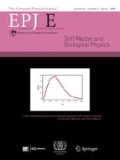Abstract.
Many physical systems can be mapped onto solved or “solvable” models of magnetism. In this work, we have mapped the statistical mechanics of columnar phases of ideally helical rigid DNA --subject to the earlier found unusual, frustrated pair potential (A.A. Kornyshev, S. Leikin, J. Chem. Phys. 107, 3656 (1997))-- onto an exotic, unknown variant of the XY model on a fixed or restructurable lattice. Here, the role of the “spin” is played by the azimuthal orientation of the molecules. We have solved this model using a Hartree-Fock approximation, ground-state calculations, and finite-temperature Monte Carlo simulations. We have found peculiar spin order transitions, which may also be accompanied by positional restructuring, from hexagonal to rhombohedric lattices. Some of these have been experimentally observed in dense columnar aggregates. Note that DNA columnar phases are of great interest in biophysical research, not only because they are a useful in vitro tool for the study of DNA condensation, but also since these structures have been detected in living matter. Within the approximations made, our study provides insight into the statistical mechanics of these systems.
Similar content being viewed by others
References
F. Livolant, A. Leforestier, Prog. Polym. Sci. 21, 1115 (1996).
R. Langridge, H.R. Wilson, C.W. Hooper, M.H.F. Wilkins, L.D. Hamilton, J. Mol. Biol. 2, 19 (1960).
C. Robinson, Tetrahedron 13, 219 (1961).
H.H. Strey , Phys. Rev. Lett. 84, 3105 (2000).
T.E. Strzelecka, M.W. Davidson, R.L. Rill, Nature 331, 457 (1988).
Z. Reich, E.J. Wachtel, A. Minsky, Science 264, 1460 (1994).
V.A. Bloomfield, Curr. Opin. Struct. Biol. 6, 334 (1996).
W.M. Gelbart, R.F. Bruinsma, P.A. Pincus, V.A. Parsegian, Phys. Today 53, 38 (2000).
H.H. Strey, R. Podgornik, D.C. Rau, V.A. Parsegian, Curr. Opin. Struct. Biol. 8, 309 (1998).
R. Podgornik, H.H. Strey, V.A. Parsegian, Curr. Opin. Colloid Interface Sci. 3, 534 (1998).
B.M. Weiner, N. Kleckner, Cell 77, 977 (1994).
F. Oosawa, Biopolymers 6, 134 (1968).
A.A. Kornyshev, S. Leikin, J. Chem. Phys. 107, 3656 (1997)
A.A. Kornyshev, S. Leikin, Phys. Rev. Lett. 82, 4138 (1999).
A.A. Kornyshev, S. Leikin, Biophys. J. 75, 2513 (1998).
H.M. Harreis, A.A. Kornyshev, C.N. Likos, H. Löwen, G. Sutmann, Phys. Rev. Lett. 89, 018303 (2002).
V. Lorman, R. Podgornik, B. Žekš, Phys. Rev. Lett. 87, 218101 (2001).
A.A. Kornyshev, S. Leikin, Phys. Rev. E 62, 2576 (2000).
A.A. Kornyshev, S. Leikin, Phys. Rev. Lett. 86, 3666 (2001) (DNA need not unzip, Phys. Rev. Focus (http://focus.aps.org/v7/st19.html)).
D.J. Lee, A. Wynveen, A.A. Kornyshev, Phys. Rev. E 70, 051913 (2004).
R.B. Potts, Proc. Cambridge Philos. Soc. 48, 106 (1952).
A.G. Cherstvy, A.A. Kornyshev, S. Leikin, J. Phys. Chem. B 108, 6508 (2004).
S. Samuel, Phys. Rev. B 25, 1755 (1982).
J.M. Kosterlitz, D.J. Thouless, J. Phys. C 6, 1181 (1973).
There are 6 distinct topological ground states corresponding to the broken symmetries of the Potts state. 3 states are got through translations of the lattice, the other three are got by changing the staggered helicity (defined later in the text). However, what seems to matter in this transition is the change in staggered helicity.
D.H. Lee, J.D. Joannopoulos, J.W. Negele, D.P. Landau, Phys. Rev. B 33, 450 (1986).
Unfortunately, including topological excitations in a systematic manner is an involved and difficult process. Indeed, in the pure XY model vortices have been included in analytical calculations (S. Ami, H. Kleinert, Phys. Rev. B 33, 4692 (1986)). These calculations are complicated, but do lead to good agreement from zero temperature right up to the BKT transition. However, we have decided that, since this is a first time study, a theoretical treatment including topological excitations is beyond the scope of the present work.
A.G. Cherstvy, A.A. Kornyshev, S. Leikin, J. Phys. Chem. B 106, 13362 (2002).
T.E. Strzelecka, R.L. Rill, J. Am. Chem. Soc. 109, 4513 (1987).
D. Durand, J. Doucet, F. Livolant, J. Phys. II 2, 1769 (1992).
E. Allahyarov, G. Gompper, H. Löwen, Phys. Rev. E 69, 041904 (2004).
A.H.A. Tajmir-Riahi , J. Biomol. Struct. Dyn. 11, 83, (1993)
A.A. Kornyshev, D.J. Lee, S. Leikin, A. Wynveen, S.B. Zimmerman, in preparation.
K. Kassapidou, J.R.C. van der Maarel, Eur. Phys. J. B 3, 471 (1998).
For a review see, A.A. Kornyshev, in The Chemical Physics of Solvation, Part A: Theory of Solvation, edited by R.R. Dogonadze, E. Kalman, A.A. Kornyshev, J. Ulstrup (Elsevier, Amsterdam, 1985) Chapt. 3
A.A. Kornyshev, A. Wynveen, Phys. Rev. E 69, 041905 (2004).
As an example using the hexagonal Brillouin zone, see C. Honerkamp, Phys. Rev. B 68, 104510 (2003).
For those interested in the steps in the calculation but less experienced in diagrammatic perturbation theory, we refer to Daniel J. Amit, Field Theory, the Renormalization Group, and Critical Phenomena (World Scientific, 1997)
Author information
Authors and Affiliations
Corresponding author
Rights and permissions
About this article
Cite this article
Wynveen, A., Lee, D.J. & Kornyshev, A.A. Statistical mechanics of columnar DNA assemblies. Eur. Phys. J. E 16, 303–318 (2005). https://doi.org/10.1140/epje/i2004-10087-y
Received:
Accepted:
Published:
Issue Date:
DOI: https://doi.org/10.1140/epje/i2004-10087-y




